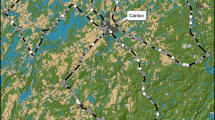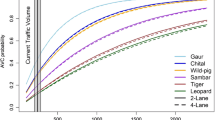Abstract
Roads and traffic have various negative ecological and environmental consequences on wildlife. Their impacts on animal populations are not limited to deaths. The main goal of the study is to analyze the spatial patterns of wildlife–vehicle collisions (WVC) at the Ankara–Kırıkkale highway. More specifically, we identified the road- and landscape-related features that may promote the WVC likelihood and locate the WVC hotspots. The hotspots of WVC were generated by CrimeStat 3 software. Variables related to the WVC locations were statistically analyzed, and then, they were modelled with logit regression approach. A total of 76 medium and large mammal were recorded from five species. The number of high-, medium-, and low-density clusters in the hotspots map that contains all the accidents are one, two, and four, respectively. For all species, the model shows that the probability of a fatal accident increases as the speed limit increases and the road slope decreases. To spatially identify where these events are concentrated provides valuable information for reducing the accidents and creating the correct strategies to ensure the safe migratory movements of wild animals.


Similar content being viewed by others
References
Alexander SM, Waters NM, Paquet PC (2005) Traffic volume and highway permeability for a mammalian community in the Canadian Rocky Mountains. Can Geographer/le Géographe Canadien 49(4):321–331
Anderson TK (2009) Kernel density estimation and K-means clustering to profile road accident hotspots. Accid Anal Prev 41:359–364
Bashore TL, Tzilkowski WM, Bellis ED (1985) Analysis of deer vehicle collision sites in Pennsylvania. J Wildlife Manage 49:69–774
Beaudry F, Demaynadier PG, Hunter ML (2008) Identifying road mortality threat at multiple spatial scales for semiaquatic turtles. Biol Cons 141:2550–2563
Blanco JC, Cortés Y, Virgós E (2005) Wolf response to two kinds of barriers in an agricultural habitat in Spain. Can J Zool 83(2):312–323
Borda-de-Água L, Navarro L, Gavinhos C, Pereira HM (2011) Spatio-temporal impacts of roads on the persistence of populations: analytic and numerical approaches. Landscape Ecol 26(2):253–265
Bülbül U, Eroğlu Aİ, Kutrup B, Kurnaz M, Koç H, Odabaş Y (2019) Road kills of amphibian and reptile species in Edirne and Kırklareli Provinces of Turkey. Sinop Üniversitesi Fen Bilimleri Dergisi 4(2):109–121
Çağlayan SD (2011) The assesment of fragmentation caused by roads in Turkey’s protected areas and key biodıversity areas. Dissertation, Ankara University (in Turkish)
Cain AT, Tuovila VR, Hewitt DG, Tewes ME (2003) Effects of a highway and mitigation projects on bobcats in Southern Texas. Biol Cons 114(2):189–197
Clevenger AP, Chruszcz B, Gunson KE (2003) Spatial patterns and factors influencing small vertebrate fauna road-kill aggregations. Biol Cons 109:15–26
Colino-Rabanal VJ, Lizana M, Peris SJ (2011) Factors influencing wolf Canis lupus roadkills in Northwest Spain. Eur J Wildl Res 57(3):399–409
Cureton JC, Deaton R (2012) Hot moments and hot spots: identifying factors explaining temporal and spatial variation in turtle road mortality. J Wildl Manag 76(5):1047–1052
D’Amico M, Román J, De los Reyes L, Revilla E (2015) Vertebrate road-kill patterns in Mediterranean habitats: who, when and where. Biol Conserv 191:234–242
Danese M, Lazzari M, Murgante B (2008) Kernel density estimation methods for a geostatistical approach in seismic risk analysis: the case study of Potenza Hilltop Town (Southern Italy). In: Gervasi O, Murgante B, Lagana A, Taniar D, Mun Y, Gavrilova M (eds) Computational science and its applications—ICCSA 2008, Part I, LNCS 5072. Springer, Berlin, pp 415–429
Danks ZD, Porter WF (2010) Temporal, spatial, and landscape habitat characteristics of moose–vehicle collisions in western Maine. J Wildl Manag 74:1229–1241
Fahrig L, Rytwinski T (2009) Effects of roads on animal abundance: an empirical review and synthesis. Ecol Soc 14(1):21
Finder RA, Roseberry JL, Woolf A (1999) Site and landscape conditions at white-tailed deer/vehicle collision locations in Illinois. Landsc Urban Plan 44(2–3):77–85
Forman RTT, Alexander LE (1998) Roads and their major ecological effects. Ann Rev Ecol System 29:207–231
Forman RTT, Sperling D, Bissonette JA, Clevenger AP, Cutshal CC, Dale VH, Fahrig L et al (2003) Road ecology: science and solutions. Island Press, Washington, DC
Gomes L, Grilo C, Silva C, Mira A (2009) Identification methods and deterministic factors of owl roadkill hotspot locations in Mediterranean landscapes. Ecol Res 24:355–370
Grilo C, Bissonette JA, Santos-Reis M (2009) Spatial-temporal patterns in Mediterranean carnivore road casualties: consequences for mitigation. Biol Cons 142:301–313
Gunson KE, Mountrakis G, Quackenbush LJ (2011) Spatial wildlife-vehicle collision models: a review of current work and its application to transportation mitigation projects. J Environ Manage 92(4):1074–1082
Güven Y (2019) Effects of traffic and highways on mammals in Çankırı province. Dissertation, Çankırı Karatekin University (in Turkish)
Heffner RA, Butler MJ, Reilly CK (1996) Pseudoreplication revisited. Ecology 77(8):2558–2562
Holsbeek J, Rodts S, Moyldermans S (1999) Hedgehog and other animal traffic victims in Belgium: results of a countrywide survey. Lutra 42:111–119
Hubbard MW, Danielson BJ, Schmitz RA (2000) Factors influencing the location of deer-vehicle accidents in Iowa. J Wildl Manag 64:707–712
Huijser MP (1999) Human impact oil populations of hedgehogs Erinaceus europaeus through traffic and changes in the landscape. Lutra 42:39–56
Huijser MP, Bergers PJM (2000) The effect of roads and traffic on hedgehog (Erinaceus europaeus) populations. Biol Cons 95:111–116
Huijser MP, McGowen PT, Fuller J, Hardy A, Kociolek A (2008) Wildlife-vehicle collision reduction study: report to Congress. Western Transportation Institute, Bozeman
Jaarsma CF, van Langevelde F, Botma H (2006) Flattened fauna and mitigation: traffic victims related to road, traffic, vehicle, and species characteristics. Transp Res Part d: Transp Environ 11(4):264–276
KGM (2019) Road network information. General Directorate of Highways, Turkey.
Kuter S, Usul N, Kuter N (2011) Bandwidth determination for kernel density analysis of wildfire events at forest sub-district scale. Ecol Model 222(17):3033–3040
Lagos L, Picos J, Valero E (2012) Temporal pattern of wild ungulate-related traffic accidents in northwest Spain. Eur J Wildl Res 58(4):661–668
Levine N (2006) The CrimeStat program: characteristics, use and audience. Geogr Anal 38:41–56
Lode T (2000) Effect of a motorway on mortality and isolation of wildlife populations. J Hum Environ 29(3):163–166
Malo JE, Suarez F, Diez A (2004) Can we mitigate animal-vehicle accidents using predictive models? J Appl Ecol 41:701–710
Manly BFL, McDonald L, Thomas DL, McDonald TL, Erickson WP (2002) Resource selection by animals: statistical design and analysis for field studies. Springer Science and Business Media, New York
Nielsen CK, Anderson RG, Grund MD (2003) Landscape influences on deer-vehicle accident areas in an urban environment. J Wildl Manag 67(1):46–51
Norstokke DW, Zumbo BD (2010) A new non-parametric Levene test for equal variances. Psicologica 31(2):401–430
Norstokke DW, Zumbo BD, Cairns SL, Saklofske DH (2011) The operating characteristics of the non-parametric Levene test for eqaual variance with assessment and evaluation data. Pract Assesment, Res Eval 16(5):1–8
Okabe A, Yamada I (2001) The K-function method on a network and its computational implementation. Geogr Anal 33:271–290
Orlowski G, Nowak L (2004) Road mortality of hedgehogs Erinaceus spp. in farmland in Lower Silesia (South–Western Poland). Pol J Ecol 52(3):377–382
Orlowski G, Nowak L (2006) Road mortality of hedgehogs Erinaceus spp. in farmland in lower Silesia (South–Western Poland). Pol J Ecol 52:377–382
Özcan AU, Özkazanç NK (2017) Identifying the hotspots of wildlife-vehicle collision on the Çankırı-Kırıkkale highway during summer. Turk J Zool 41(4):722–730
Özcan AU (2018) Modelling on wildlife (Mammalia)-vehicle collisions in steppe area: Kırıkkale–Çankırı Highway (Unpublished doctoral dissertation). http://acikerisim.bartin.edu.tr:8080/xmlui/handle/11772/498. Accessed 15 Jan 2019
Puglisi MJ, Lindzey JS, Bellis ED (1974) Factors associated with highway mortality of white-tailed deer. J Wildl Manag 38:799–807
Ramp D, Caldwell J, Edwards KA, Warton D, Croft DB (2005) Modelling of wildlife fatality hotspots along the Snowy Mountain Highway in New South Wales, Australia. Biol Cons 126:474–490
Ramp D, Wilson VK, Croft DB (2006) Assessing the impacts of roads in periurban reserves: road-based fatalities and road usage by wildlife in the Royal National Park, New South Wales, Australia. Biol Cons 129:348–359
Rodríguez-Morales B, Díaz-Varela ER, Marey-Pérez MF (2013) Spatiotemporal analysis of vehicle collisions involving wild boar and roe deer in NW Spain. Accid Anal Prev 60:121–133
Roger E, Ramp D (2009) Incorporating habitat use in models of fauna fatalities on roads. Divers Distrib 15(2):222–231
Saeki M, Macdonald DW (2004) The effects of traffic on the raccoon dog (Nyctereutes procyonoides viverrinus) and other mammals in Japan. Biol Cons 118(5):559–571
Seaman ED, Powell R (1996) An evaluation of the accuracy of kernel density estimators for home range analysis. Ecology 77(7):2075–2085
Seiler A (2005) Predicting locations of moose-vehicle collisions in Sweden. J Appl Ecol 42:371–382
Silverman BW (1986) Density estimation for statistics and data analysis. Chapman and Hall, London
Smith-Patten BD, Patten MA (2008) Diversity, seasonality, and context of mammalian roadkills in the southern Great Plains. Environ Manage 41(6):844–852
Snow NP, Porter WF, Williams DM (2015) Underreporting of wildlife-vehicle collisions does not hinder predictive models for large ungulates. Biol Cons 181:44–53
Spellerberg IF (1998) Ecological effects of roads and traffic: a literature review. Glob Ecol Biogeogr Lett 7:317–333
Taylor BD, Goldingay RL (2004) Wildlife road-kills on three major roads in north-eastern New South Wales. Wildl Res 31(1):83–91
Tok CV, Ayaz D, Cicek K (2011) Road mortality of amphibians and reptiles in the Anatolian part of Turkey. Turk J Zool 35(6):851–857
Toyran K, Adizel Ö, Azizoğlu E (2018) Road kills of mammal species in the Van Lake Basin (Turkey). Biol Diver Conserv 11(1):40–44
Trombulak SC, Frissell CA (2000) Review of ecological effects of roads on terrestrial and aquatic communities. Biol Cons 14:18–30
Whittington J, St Clair CC, Mercer G (2004) Path tortuosity and the permeability of roads and trails to wolf movement. Ecol Soc 9(1):4
Acknowledgements
This study was supported by Scientific Research and Project Commission (BAP) of Çankırı Karatekin University under Project Number OF090316B14.
Author information
Authors and Affiliations
Corresponding author
Supplementary Information
Below is the link to the electronic supplementary material.
Rights and permissions
About this article
Cite this article
Özcan, A.U., Kutlutürk, M.M. & Kuter, S. Modelling of road-kill hotspots in steppe landscape in Turkey. Landscape Ecol Eng 18, 441–449 (2022). https://doi.org/10.1007/s11355-022-00515-9
Received:
Revised:
Accepted:
Published:
Issue Date:
DOI: https://doi.org/10.1007/s11355-022-00515-9




